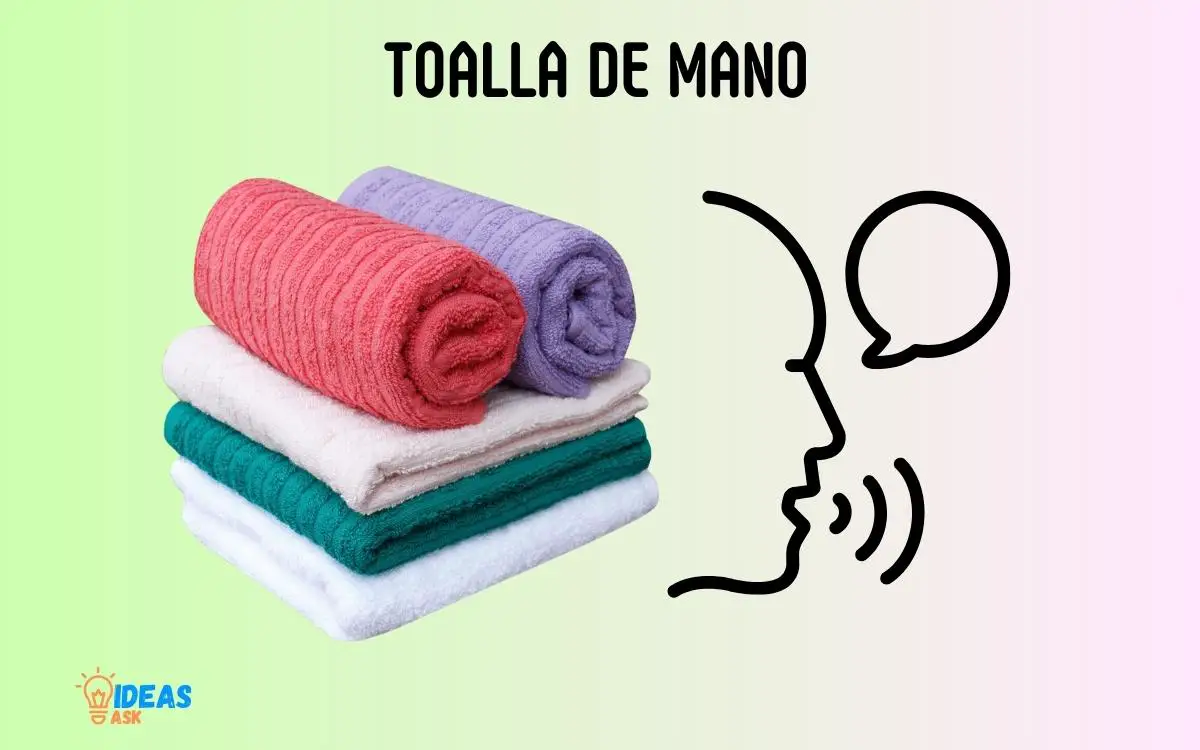How Do You Say Hand Towel in Spanish? Explained!
The term for “hand towel” in Spanish is “toalla de mano”.
In Spanish, the word “toalla” translates to “towel” and “mano” translates to “hand”. So when you combine both words, “toalla de mano”, it means “hand towel”.
The use of a hand towel, or “toalla de mano” in Spanish, is common in homes, restaurants, and hotels in Spanish-speaking countries. Just like in English, this term is used to specifically refer to the smaller towels typically used for drying hands.

Key Takeaway
Different Ways To Say Hand Towel In Spanish
Discover the various translations for “hand towel” in Spanish and expand your vocabulary. Learn how to say this common item in different ways in the Spanish language.
Looking to expand your vocabulary? Then you’ve come to the right place! In this blog post, we’ll explore the different ways to say “hand towel” in Spanish.
Whether you’re traveling to a Spanish-speaking country or simply want to impress your friends, learning these phrases will surely come in handy!
Common Spanish Terms For Hand Towel
- Toalla de mano: This is the most common term used to refer to a hand towel in Spanish. It is widely understood and used throughout the Spanish-speaking world.
- Toallita de mano: A diminutive version of “toalla de mano,” this term is often used to refer to a smaller-sized hand towel.
- Paño de manos: Another popular phrase, “paño de manos” translates to “cloth of hands.” It is commonly used in many Spanish-speaking countries.
- Toallón: This term refers to a larger-sized hand towel, typically used in public places or shared spaces. It is the equivalent of a bath towel in English.
Regional Variations For Hand Towel In Spanish
Just like with any language, there are regional variations in Spanish.
Here are a few different ways to say “hand towel” that are specific to certain Spanish-speaking countries:
- Repasador: Used primarily in Argentina, Uruguay, and Paraguay, “repasador” refers to a kitchen towel but can also be understood in the context of a hand towel.
- Pañuelo de manos: This term, often used in Spain, translates to “handkerchief,” but it can also be used to describe a hand towel.
- Toallita de acerería: In Mexico, “toallita de acerería” specifically refers to a shop towel or mechanic’s towel. However, it can also be used more generally to refer to a hand towel.
Now that you know the different ways to say “hand towel” in Spanish, you can confidently navigate your way through various Spanish-speaking countries and impress the locals with your language skills. ¡Buena suerte! (Good luck!)
Understanding Cultural Context For Hand Towel In Spanish Translation
Discover how to say “hand towel” in Spanish and understand the cultural context behind its translation, ensuring accurate communication across language barriers.
Gain insights into the linguistic nuances and cultural significance of this commonly used item. In today’s globalized world, effective communication across cultures is crucial.
When it comes to translating words and phrases, it’s important to consider the cultural context to ensure accurate and meaningful communication. This holds true for basic items like hand towels as well.
We will explore the importance of cultural sensitivity in translation, delve into the cultural factors to consider when translating the term “hand towel” into Spanish, and touch upon common translation mistakes to avoid.
Importance Of Cultural Sensitivity In Translation:
Cultural sensitivity is paramount when translating, as it helps avoid misunderstandings and promotes effective communication.
When translating the term “hand towel” into Spanish, understanding the cultural nuances is key to delivering an accurate and relatable translation.
Here are some points to consider:
- Cultural preferences: Different cultures may have varying norms and preferences when it comes to hand towels. Understanding these nuances can help ensure that the translated term aligns with the cultural context.
- Linguistic variations: Languages evolve over time and across regions, resulting in variations in vocabulary. Translators need to be aware of these variations to provide an appropriate and culturally sensitive translation.
- Etiquette and symbolism: Hand towels may hold particular symbolism or significance in certain cultures. Translators must be mindful of these cultural associations to choose the most appropriate translation.
Cultural Factors To Consider When Translating Hand Towel:
When translating the term “hand towel” into Spanish, it is essential to consider the following cultural factors:
- Spanish-speaking regions: Spanish is spoken in various countries, each with its own unique dialects and vocabulary. Take into account the specific region or target audience to ensure an accurate translation.
- Local terminology: Research the commonly used terms in the target region. For example, in Spain, “hand towel” is often referred to as “toalla de manos,” while in Latin America, it is commonly known as “toalla de mano.”
Avoiding Common Translation Mistakes For Hand Towel:
To provide an accurate translation and avoid common mistakes, keep the following points in mind:
- Literal translations: Directly translating “hand towel” into “mano toalla” may result in confusion or incorrect understanding. It’s important to consider the phrasing that native Spanish speakers would use.
- Contextual meaning: Ensure the translated term maintains the same meaning and function as the English “hand towel.” Consider the usage and purpose of hand towels in the target culture.
- Proofreading and review: After translating, have a native Spanish speaker review the translation to catch any errors or cultural discrepancies.
By understanding the cultural context, being culturally sensitive, and avoiding common translation mistakes, accurate and meaningful communication can be achieved when translating the term “hand towel” into Spanish.
Remember, attention to cultural details enhances the effectiveness of translations and bridges the gap between different communities.
Everyday Language For Hand Towel In Spanish
Hand towel in Spanish can be referred to as “toalla de mano”. This commonly used phrase is essential for anyone wanting to communicate effectively in Spanish. Practice using this everyday language to enhance your conversational skills.
Conversational Phrases For Asking For A Hand Towel
- Could you hand me a hand towel, please? : This polite request is a simple and direct way to ask someone to pass you a hand towel.
- Do you mind passing me a hand towel? : Use this phrase when you want to politely ask someone if they would be willing to give you a hand towel.
- Would it be possible for me to get a hand towel? : This question is a more formal way of asking if someone can provide you with a hand towel.
- Can you spare a hand towel for a moment? : Use this phrase for a slightly informal, yet friendly, way of requesting a hand towel.
Polite Expressions For Requesting A Hand Towel
- I would greatly appreciate it if you could give me a hand towel. : This expression conveys politeness and gratitude while making a request for a hand towel.
- Could you kindly provide me with a hand towel? : By using the word ‘kindly’, this polite request emphasizes the importance of the asker’s need for a hand towel.
- May I trouble you for a hand towel, please? : This phrase politely acknowledges that asking for a hand towel may cause some inconvenience to the person being asked.
- Would you be so kind as to give me a hand towel? : This polite expression places emphasis on the person’s kindness in offering a hand towel.
Formal Language For Discussing Hand Towel In Spanish
- El toallero de mano (The handheld towel): This formal term directly translates to ‘hand towel’ and can be used in formal settings or writing.
- El paño de manos (The hand cloth): This formal phrase is an alternative way to refer to a hand towel and is commonly used in more formal or professional contexts.
- El trapo de baño (The bathroom cloth): Although not specific to hand towels, this formal phrase can also be used to refer to a hand towel in certain formal situations.
- El tejido para manos (The fabric for hands): This formal expression emphasizes the purpose of a hand towel as a fabric for drying hands and can be used in formal discussions or written materials.
Remember to use these phrases appropriately based on the social context and level of formality required.
Incorporating them into your everyday conversations and requests will help you effectively ask for a hand towel in different settings.
Recommended Sources For Expanding Your Spanish Vocabulary Of Hand Towel
Expand your Spanish vocabulary of “hand towel” with these recommended sources. Discover new words and phrases to enhance your language skills.
Looking to expand your Spanish vocabulary to include the term “hand towel”? Fortunately, there are several excellent resources available to help you learn and practice new words.
Whether you prefer online courses, mobile apps, or traditional books and textbooks, below are some recommended sources that can assist you in mastering the Spanish language.
Online Courses And Language Learning Platforms
If you prefer a structured approach to language learning, online courses and language learning platforms are an excellent choice. These platforms offer interactive lessons, quizzes, and resources to enhance your vocabulary.
Here are a few popular options:
- Duolingo: This free app offers bite-sized lessons that make learning Spanish enjoyable and engaging. Through interactive activities, you can practice vocabulary related to hand towels and many other topics.
- Babbel: Known for its focus on real-life conversations, Babbel provides comprehensive Spanish courses that cover various themes. You can explore lessons on household items, including hand towels, while improving your overall language skills.
- Rosetta Stone: With its immersive teaching method, Rosetta Stone offers interactive lessons that teach Spanish through context and visual cues. This platform will introduce you to useful vocabulary, including the term “hand towel.”
Mobile Apps For Spanish Language Learning
If you are constantly on the go, mobile apps can be a convenient way to learn and practice Spanish vocabulary anytime, anywhere.
Here are a few top-rated apps:
- Memrise: Memrise combines spaced repetition and gamification techniques to help you memorize new vocabulary effectively. You can find courses specifically focused on household items like hand towels.
- HelloTalk: This language exchange app allows you to connect with native Spanish speakers for conversation practice. You can learn new words related to hand towels and improve your overall language skills through real-life conversations.
- FluentU: Featuring authentic Spanish videos with interactive subtitles, FluentU helps you immerse yourself in the language. You can learn new vocabulary related to hand towels while watching engaging videos.
Books And Textbooks For Vocabulary Expansion
If you prefer a more traditional approach to learning, books and textbooks can serve as valuable resources for expanding your Spanish vocabulary.
Consider the following options:
- “Spanish Vocabulary Builder” by Myelin Media: This comprehensive guide provides a range of vocabulary topics, including everyday household items like hand towels. It presents words in context, making it easier to remember and use them in real-life situations.
- “Spanish Verb Drills” by Vivienne Bey: While focusing on verbs, this book covers a broad spectrum of vocabulary, including terms related to household items. By practicing with the exercises, you can reinforce your understanding of words like “hand towel.”
- “Living Language Spanish” by Living Language: This textbook offers a comprehensive curriculum for learning Spanish. It includes vocabulary lists, exercises, and dialogues that cover various topics, such as household items, where you can find the term “hand towel.”
Expand your Spanish vocabulary effectively by utilizing these recommended sources, whether you prefer online courses, mobile apps, or traditional books and textbooks.
With consistent practice and exposure to relevant vocabulary, you’ll soon be confidently using the Spanish term for “hand towel” and many other words.
¡Buena suerte! (Good luck!)
Using The Correct Term For Hand Towel In Various Situations
Hand towels are called “toallas de mano” in Spanish. Whether you’re shopping for towels or discussing bathroom decor, knowing the correct term is essential. Upgrade your language skills and impress others with the right Spanish translation for hand towels.
We will explore different scenarios where you might need to use the term “hand towel” in Spanish, ensuring you use the correct terminology.
Whether you’re traveling, at home, or out shopping, it’s important to know the appropriate vocabulary for hand towels.
Travel Scenarios: Asking For A Hand Towel In Hotels And Restaurants
When you’re traveling in Spanish-speaking countries and find yourself needing a hand towel, it’s essential to know the right way to ask for it.
Here are some useful phrases and vocabulary to help you navigate these situations:
- Scenario: Checking into a hotel
- Phrase 1: “¿Podría proporcionarme una toalla de manos, por favor?” (Could you provide me with a hand towel, please?)
- Phrase 2: “¿Tienen toallas de manos disponibles en la habitación?” (Do you have hand towels available in the room?)
- Scenario: Dining at a restaurant
- Phrase 1: “¿Podría traerme una toalla de manos para limpiarme, por favor?” (Could you bring me a hand towel to clean myself, please?)
- Phrase 2: “¿Tienen toallas de manos en el baño?” (Do you have hand towels in the restroom?)
Remember to use these phrases politely to ensure clear communication in these situations.
Home And Daily Life: Describing Hand Towels And Their Usage In Spanish
In your everyday life at home, it can be helpful to know how to describe hand towels and discuss their usage in Spanish.
Here are some vocabulary terms and phrases that will come in handy:
Vocabulary:
- Term 1: “Toalla de manos” (Hand towel)
- Term 2: “Toallita” (Small towel)
- Term 3: “Toallero” (Towel rack)
Describing usage:
- Phrase 1: “Las toallas de manos se utilizan para secar las manos después de lavarlas.” (Hand towels are used to dry hands after washing them.)
- Phrase 2: “Se recomienda tener un toallero en el baño para colgar las toallas de manos.” (It is recommended to have a towel rack in the bathroom to hang hand towels.)
Having a good understanding of these terms and phrases will allow you to discuss hand towels effortlessly in your daily life.
Shopping Situations: Identifying Hand Towels And Making Purchases In Spanish
When shopping for hand towels in Spanish-speaking countries, it’s important to know how to identify them and interact with the salesperson.
Here are some key phrases and vocabulary to help you navigate shopping situations:
Identifying hand towels:
- Phrase 1: “Estoy buscando toallas de manos de algodón.” (I’m looking for cotton hand towels.)
- Phrase 2: “¿Podría mostrarme dónde están las toallas de manos?” (Could you show me where the hand towels are?)
Making purchases:
- Phrase 1: “Me gustaría comprar estas toallas de manos, por favor.” (I would like to buy these hand towels, please.)
- Phrase 2: “¿Cuánto cuestan las toallas de manos?” (How much do the hand towels cost?)
By using these phrases, you’ll be able to find and purchase hand towels confidently when shopping in Spanish-speaking countries.
Remember to practice these phrases and vocabulary to improve your fluency and make your daily interactions smoother.
Enjoy your conversations about hand towels in Spanish!
Conclusion
In a nutshell, learning how to say “hand towel” in Spanish opens up a whole new world of language and culture. From “toallita de mano” to “toalla de mano,” there are various terms you can use depending on the region.
Whether you’re planning a trip to a Spanish-speaking country or simply want to expand your vocabulary, knowing the right words for everyday items can make a huge difference.
Additionally, understanding the nuances of language and how it differs across cultures can spark a sense of appreciation and curiosity.
So, don’t shy away from exploring new words and phrases in different languages. Embrace the beauty of linguistic diversity, and you’ll find yourself connecting with others in profound ways, all while enhancing your own personal growth.
Happy language learning!






